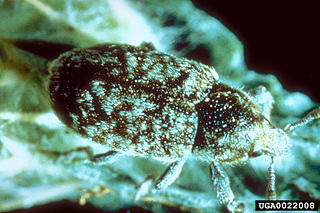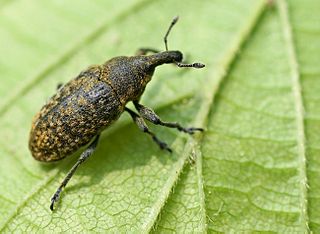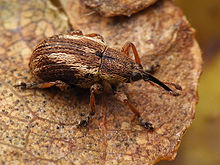
Cytisus scoparius, the common broom or Scotch broom, is a deciduous leguminous shrub native to western and central Europe. In Britain and Ireland, the standard name is broom; this name is also used for other members of the Genisteae tribe, such as French broom or Spanish broom; and the term common broom is sometimes used for clarification. In other English-speaking countries, the most common name is "Scotch broom" ; however, it is known as English broom in Australia.

Onopordum acanthium is a flowering plant in the family Asteraceae. It is native to Europe and Western Asia from the Iberian Peninsula east to Kazakhstan, and north to central Scandinavia, and widely naturalised elsewhere, with especially large populations present in the United States and Australia. It is a vigorous biennial plant with coarse, spiny leaves and conspicuous spiny-winged stems.

Centaurea solstitialis, the yellow star-thistle, is a species of thorny plant in the genus Centaurea, which is part of the family Asteraceae. A winter annual, it is native to the Mediterranean Basin region and invasive in many other places. It is also known as golden starthistle, yellow cockspur and St. Barnaby's thistle.

Bruchidius villosus is a species of bean weevil known by the common names broom seed beetle and Scotch broom bruchid. This beetle is used as an agent of biological pest control against the noxious weed known as Scotch broom.

Leucoptera spartifoliella is a species of moth in family Lyonetiidae known by the common name Scotch broom twig miner. It is used as an agent of biological pest control against the noxious weed known as Scotch broom.

Cyrtobagous salviniae is a species of weevil known as the salvinia weevil. It is used as an agent of biological pest control against the noxious aquatic plant giant salvinia.

Exapion ulicis is a species of straight-snouted weevil known by the general common name Gorse Seed Weevil. It is used as an agent of biological pest control against Common Gorse, which is classified as a noxious weed in some countries.

Exapion is a genus of straight-snouted weevils.

Bangasternus fausti is a species of true weevil known as the broad-nosed seed head weevil. It is used as an agent of biological pest control against noxious knapweeds, particularly spotted knapweed, squarrose knapweed, and diffuse knapweed.

Cyphocleonus achates is a species of true weevil known as the knapweed root weevil. It is native to southern Europe and the Mediterranean and is used as an agent of biological pest control against noxious knapweeds, especially spotted knapweed. It has recently been spotted in India.
Larinus minutus is a species of true weevil known as the lesser knapweed flower weevil. It is used as an agent of biological pest control against noxious knapweeds, especially diffuse knapweed and spotted knapweed.

Larinus obtusus is a species of true weevil known as the blunt knapweed flower weevil. It is used as an agent of biological pest control against noxious knapweeds, especially spotted knapweed.
Phrydiuchus tau is a species of true weevils known as the Mediterranean sage root weevil. It is used as an agent of biological pest control against noxious weed Mediterranean sage.

Rhinocyllus conicus is a species of true weevil. It is best known as a controversial agent of biological pest control which has been used against noxious thistles in the genera Carduus, Cirsium, Onopordum, and Silybum.

Eustenopus villosus is a species of true weevil known as the yellow starthistle hairy weevil. It is used as an agent of biological pest control against the noxious weed yellow starthistle.

Larinus curtus is a species of true weevil known as the yellow starthistle flower weevil. It is native to Southern Italy, Southern Europe, the Middle East and the Caucasuses. It is used as an agent of biological pest control against the noxious weed yellow starthistle in the United States.

Larinus planus is an insect of the Curculionidae family. They are oval shaped, dark brown or black, and about 5–10 millimetres long. While native to Europe, it is also common in North America. It feeds on floral buds, primarily of thistles, with the larvae stage being the most destructive to them. In North America, it has been used as a biocontrol agent. It is also known as Larinus carlinae.

Oxyops vitiosa is a species of weevil in the family Curculionidae. Common names include the melaleuca leaf weevil and the melaleuca snout beetle. It feeds on the leaves and shoots of the broad-leaved paper bark tree, Melaleuca quinquenervia, which is endemic to Australia where it grows on seasonally inundated plains and swampland, and was introduced into Florida in order to help drain flooded portions of the Everglades.

Hylobius transversovittatus is a species of weevil in the family Curculionidae. It is native to the Old World where both adults and larvae feed on purple loosestrife. This plant is regarded as an invasive species in North America and the weevil has been introduced into both the United States and Canada in an effort to control the plant.
















